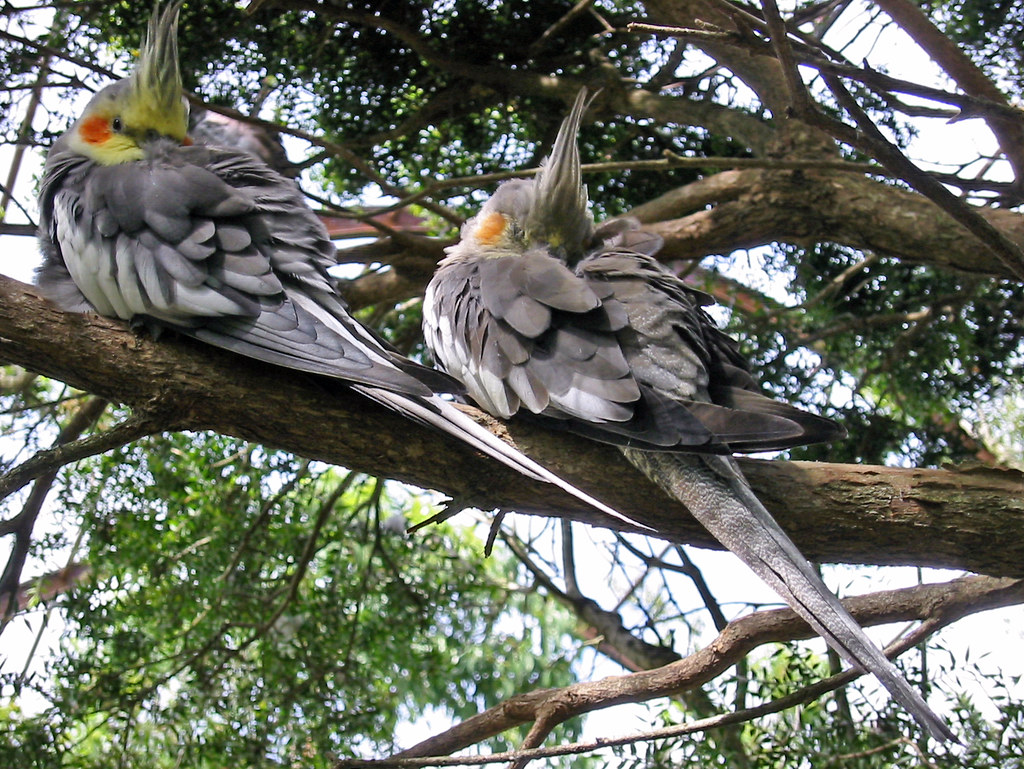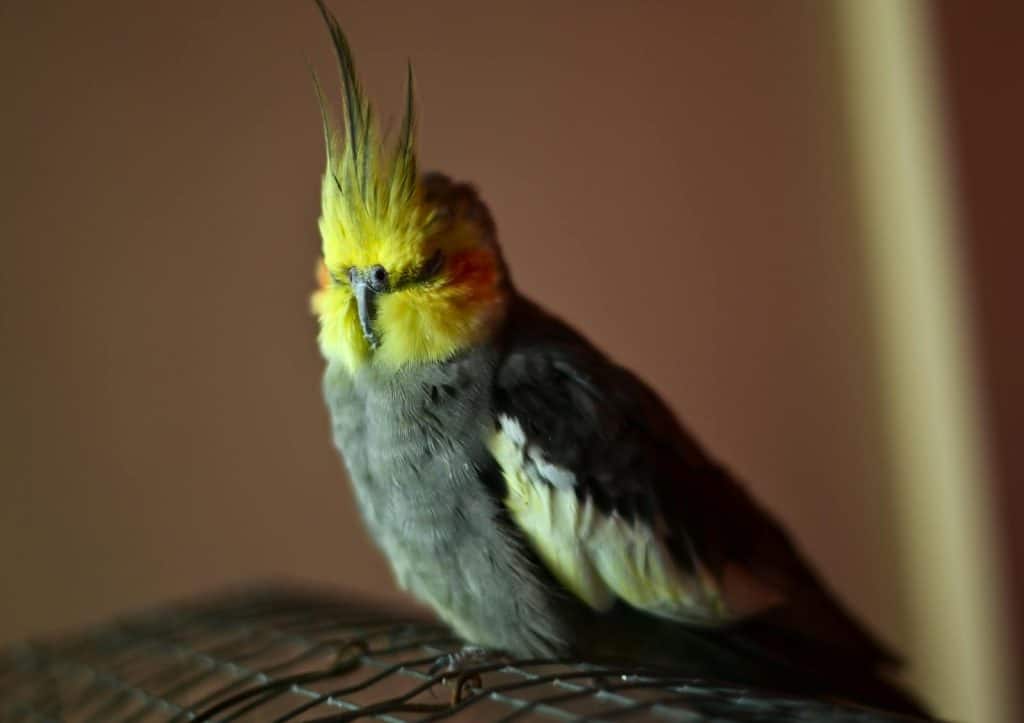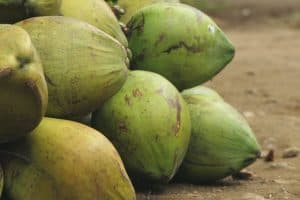Is your cockatiel looking a bit disheveled lately? Noticed a flurry of feathers at the bottom of the cage and a hint of irritation in its behavior? Don’t be alarmed if your cockatiel seems unusually moody—this is a sign that your cockatiel is molting. Molting is a natural and recurring process for your bird, though it can bring a few weeks of discomfort.
Learn all about what it means when your cockatiel is molting and find out how you can help make the process more comfortable for your feathered friend.
What is a molt?

Cockatiels spend a lot of time in the outdoors, and their feathers are subjected to a variety of elements on a daily basis. The only thing that will make them look really old after a year or two is if they don’t replace their feathers on a regular basis. That is precisely what molting is: a period when part of your cockatiel’s (or other parrot’s) feathers are traded for new, healthy feathers.
The first molt on a cockatiel generally happens when the bird is nearing a year old. This is when they shed their juvenile feathers, before the initial molt, all wild-type cockatiels are grey, whereas males develop a yellow face once they become adults.
After this first molt, your cockatiel will continue to go through heavy shedding about twice a year (and very light molting throughout all months). You’ll know when it happens: you’ll find lots of feathers and flakes everywhere and see the bird preening itself more often. And it definitely won’t look its best, since a feather that falls out isn’t immediately replaced with a new one.
A pinfeather is a type of keratinized, unpigmented feather. Pinfeathers are constructed similarly to developing feathers that are covered in a sheath of keratin (the substance that feathers, beaks, and nails are composed of). A fresh feather will not generate a pinfeather. The sheath protects the growing feathers, which are directly linked to the cockatiels’ blood circulation and might result in serious bleeding if injured.
The ‘pin’ falls off once the new feather is fully developed. If your cockatiel has a lot of pinfeathers during a big molt, it may appear quite wormy, but this is completely normal!
Did you know? During the spring, many birds shed their feathers. They can appear new again during the nesting months, and their lush new feather coat will attract a mate. It may also help remove excess down that species in colder climes grow for the cold season.
The Process of Molting
The outermost layer of the insect’s epidermis, known as the cuticle, separates from the rest of it during molting. Then, while preserving itself with a protective covering and secreting chemicals to dissolve the old cuticle’s insides, the epidermis forms a new protective layer around itself. That defensive barrier becomes part
To grow, the caterpillar must fill in the defective area of its body, which comprises an old cuticle that has been shed. The result is a new cuticle that contains space for growth and needs time to form correctly. The new overcoat is softer and paler than the previous one, but after a few hours, it resembles its former self and begins to harden. The insect appears to be a somewhat larger version of itself within a few days.
- TRAINING TO KEEP FITParrots are the cleverest and cutest bird,that is why we keep it as a pet.But without always flying in the air and artificial feeding,they are vulnerable and easily get sick.This stand can let your bird get well trained,of course,with your help,and get more exercises to keep fit.
- 100% NATURAL AND ENVIRONMENTALLY FRIENDLYThe Hamiledyibird stand is made from 100% natural pine wood, and all the parts are connected with screws ,not glue.This way,the stand is more sturdy and more stable, firm and environmental protection.The perch surface polished smooth, will not hurt the bird feet.
- ENJOY GOOD TIMEFun to play, climb and rest, relieve boredom and increase activity levels, Perch toys provide a nice and comfortable place, with ladder swings and bells for your pet to play and exercise.
- STAINLESS STEEL FEEDER CUPS AND BASEThe bird perch comes with two stainless steel feeder cups that allow the bird to eat or drink while playing and resting, And a stainless steel base,easy to clean and durable in use, just wash by the water.
- PERFECT SIZEThe size of the bird perch is L14.1 x W9.1 x H17.7 inches,the size of the stainless steel base is L12.6 x W8.7 inches,The height of the feeding cup is 2 inches,diameter 2inch.Suitable for cockatiel, parakeet, yellow-vented parrots, gcc, sun conure, lorikeet, pionites, such small and medium sized birds,Not suitable for large birds, please purchase with caution.
What happens to your cockatiel during molting?
A bird never loses all of its feathers at once. After all, if it couldn’t fly, it would be defenseless against predators, which is the primary means of self-defense for most species. However, being a bird isn’t exactly the greatest time to do anything.
- Feeling tired. When growing all those new feathers, a budgerigar’s body consumes a lot of nutrients and energy. It’ll most likely want to sleep more than usual and may not have the energy to sing or play as it normally would.
- Feeling uncomfortable. It’s not hard to believe that having your feathers lost and then being enveloped in keratin sheaths is an unpleasant experience. Pinfeathers are extremely irritating for your bird! It’ll probably be preening, scratching itself, or rubbing its head on things to get rid of the pins. It might be too uncomfortable to want anything to do
- Feeling vulnerable. Although your cockatiel will generally be able to fly, it won’t feel quite as safe during its molt. Depleting all of that energy drains its system and makes it seem like it won’t be able to escape potential threats; at least not as well as usual. It’ll go into darker nooks more frequently and perhaps try to keep
Tip: Is your cockatiel losing a lot of feathers and looking bare all the time? Has it gone through more than two molts in less than a year, or has it undergone three or more moltings in a single year? It’s possible that you’ll want to see a veterinarian just to be sure everything is OK.
Understanding Feather Loss and Molting in Cockatiels

When your cockatiel is molting, it’s not just about the loss of a few feathers; it’s a comprehensive process involving all types of feathers. Here’s a deeper look into how different feathers play a role in this natural cycle and what you can do to help your pet bird through it.
Tail Feathers and Wing Feathers
Among the feathers your cockatiel will shed are the tail feathers and wing feathers. These flight feathers are crucial for balance and maneuverability. As your cockatiel loses these feathers, it may have difficulty flying or seem less agile. This is normal, but it’s important to ensure that your bird has a safe environment to prevent injuries while it’s adjusting to the changes.
Understanding Feather Loss and Molting in Cockatiels

When your cockatiel is molting, it’s not just about the loss of a few feathers; it’s a comprehensive process involving all types of feathers. Here’s a deeper look into how different feathers play a role in this natural cycle and what you can do to help your pet bird through it.
Tail Feathers and Wing Feathers
Among the feathers your cockatiel will shed are the tail feathers and wing feathers. These flight feathers are crucial for balance and maneuverability. As your cockatiel loses these feathers, it may have difficulty flying or seem less agile. This is normal, but it’s important to ensure that your bird has a safe environment to prevent injuries while it’s adjusting to the changes.
Body Feathers and Small Feathers
In addition to the larger flight feathers, your cockatiel will also molt its body feathers and small feathers. These feathers are essential for insulation and maintaining body temperature. You might notice a significant amount of old feathers and pin feathers around the cage. This shedding is a normal part of the molting process, and while it can make your bird look a bit scruffy, it’s a sign that new, healthy feathers are on their way.
Blood Feathers and Pin Feathers
Blood feathers are newly grown feathers that are still developing their blood supply. They are crucial to watch because if they get damaged, it can cause bleeding. It’s important to handle your cockatiel gently during this time and avoid any activities that could lead to injury. Pin feathers, which are covered in a sheath of keratin, can be quite uncomfortable for your bird as they grow. Your cockatiel will spend a lot of time preening to relieve the irritation from these pin feathers.
Caring for Your Cockatiel During Molting
- Monitor Feather Loss: If your cockatiel is losing feathers excessively or seems to be undergoing multiple molts in a short period, it might be worth consulting an avian vet. Excessive feather loss can sometimes be a sign of underlying health issues.
- Provide a Nutritious Diet: Ensure your cockatiel’s diet is rich in the necessary nutrients to support feather growth. A balanced diet will help your bird replace its old feathers with strong, healthy ones.
- Maintain a Clean Environment: Keep the cage clean and free from excessive feathers. This will help prevent infections and provide a comfortable space for your cockatiel to relax.
- Comfort and Safety: Ensure your bird’s environment is secure and stress-free. Provide plenty of perches and toys to keep your cockatiel occupied and comfortable while it grows its new feathers.
Final Thoughts
Molting is a natural, albeit uncomfortable, part of your cockatiel’s life cycle. Understanding the different types of feathers involved and the challenges your pet bird faces during this time can help you provide better care. By ensuring a nutritious diet, maintaining a clean environment, and keeping your cockatiel’s surroundings safe, you can support your bird through this transition. Remember, molting is temporary, and with the right care, your cockatiel will soon have a beautiful, healthy plumage.
If you notice any signs of excessive discomfort or unusual feather loss, don’t hesitate to consult an avian vet to rule out any health issues. Your vigilance can make all the difference in your bird’s comfort and well-being.




